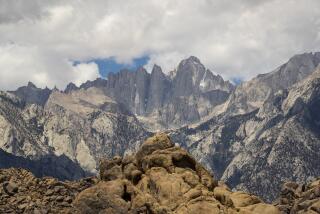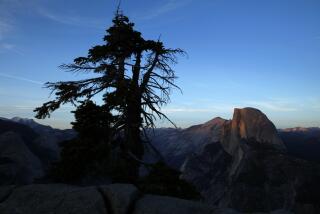Ice Climbing--A Sport They Can Really Sink Their Teeth Into
JUNE LAKE, Calif. — Four teeth of sharpened steel--the front points of his crampons--were all that supported Jim Gaines 80 feet up an ice cube.
Gaines, a 40-year-old high school teacher from Long Beach, scrutinized the ice for a solid hold. Settling on a spot, he sank his ice ax. Until now, Gaines had been serenaded by the crunch of his own crampons and the crack of the axes he held in each hand for balance and backup should a foothold give way. But suddenly, here was a new sound.
Gaines worked the ax out again and the noise--a persistent gurgle--grew louder. In the hole left by the pick, he saw that he had broken through the ice to expose water streaming down the rock.
Although he’d known this was the nature of the climb all along, Gaines said he was exhilarated by the evidence before him--he was actually clinging to a partially frozen waterfall.
For generations, mountaineers have been tackling glaciers. Opaque and well-aerated Alpine ice, as glacier ice is called, is easily carved and presents a stable surface for climbers. The fast-frozen ice of a waterfall (it’s called water ice), on the other hand, is clear, airless and extremely brittle. It’s the most unreliable substance a climber could chose to support his or her weight.
“It was not possible to climb vertical water ice until the mid ‘60s,” said ice climbing instructor Doug Robinson. “The best climbers in the world couldn’t do it.” The event that finally made frozen falls accessible was the development, by Ventura-based mountaineer and equipment manufacturer Yvon Chouinard, of a modified ax that grips steep, splintery ice where other axes have failed.
Small Boom Under Way Even after the introduction of this and other ice-specific equipment, mountaineers were slow to accept the idea that frozen waterfalls could at last be climbed relatively safely. It’s only within the last few years that there’s been a small boom in water ice climbing.
“People are starting to realize it’s a sport,” said Mimi Vadasz, co-director of the Alpine Skills Institute, which sponsors waterfall climbing classes.
For the last two winters, Vadasz said she’s seen as many as 10 or 15 climbers a day traipsing past the institute’s winter lodge at Donner Pass en route to a local waterfall. It’s gotten so popular, she said, that you can no longer depend on having the ice to yourself.
This is not to say that everyone who tries the sport becomes a convert. As well as being the most difficult type of mountaineering to master, there’s also the weather.
“For most people, the sport seems so cold,” Vadasz said. “That does scare a lot of people off.”
Jim Martin awoke in the night and sensed that something was wrong in his unheated camper. It was below zero outside in June Lake--Mammoth’s more modest neighbor--but it wasn’t the cold that had awakened Martin, a carpenter from San Francisco. It was that his alarm clock, frozen into silence, had stopped ticking.
Martin pulled the freezing metal into his down bag and cradled the clock to his chest until it thawed enough to begin ticking again. Then he dropped off to sleep.
In the morning, Martin joined nine other men and women in the Sierra Inn Cafe, about 350 miles north of Los Angeles. They were there to learn to climb a waterfall in a class offered by the the Alpine Skills Institute and taught by Doug Robinson and Leslie Hastings, free-lance mountain guides. Realizing that food would be the only fuel that would warm them all day, the climbers ordered large amounts of eggs, sweet rolls, potatoes, milk and coffee.
“What kind of gear should we bring?” a class member asked Robinson.
No Need for Sunscreen Robinson raised a bandaged hand from his plate of French toast (he’d fallen the day before while rock climbing and had cut his hand, requiring stitches) and looked out the window. The sky was blue--but that wouldn’t matter where they were going.
“Lots of clothes,” Robinson said, lowering his fork to his plate again. “You won’t be needing your No. 15 sunscreen or your dark glasses.” A rule of the game: Where you find the best ice, you won’t find any sun.
Robinson warned the group that the sport they were about to attempt is the most dangerous facet of mountaineering. There’s the possibility of avalanche. Crashing slabs of ice knocked loose by climbers above can knock out a crampon or cause head injuries. And since ice climbers have sharp implements strapped to every extremity, even a short fall can be devastating. Robinson said he has holes in both legs from being speared with tools when he fell ice climbing.
Beginners learning to climb rock are often encouraged to take falls in order to build trust in the safety ropes. That’s not so on ice. Even though the climbers would be harnessed to a rope that would catch them in a fall, Robinson warned the group: “We’re going to try not to fall at all. It’s just too dangerous. All of this is not to say that ice climbing is a death-defying business--but there are a lot of ways to get hurt.”
The class hiked in after breakfast to find that the model waterfall promised in the course description had shriveled and rechanneled since the last time Robinson had scaled it. It was now unclimbable by beginners. There were lessons to be had from this, the instructor pointed out.
The first is that if you intend to go seeking waterfalls in California--which is essentially a desert environment--be prepared for an occasional disappointment. Except in the rare seasons when Yosemite Valley freezes, allowing access to some of the most glorious water ice anywhere, the wetter mountains of the Northwest and Canada are better hunting grounds for waterfall climbs.
Second lesson: Ice changes hourly. A rock face, once conquered, is no longer much of a challenge. A waterfall, however, may in the course of one day change from mirror-hard ice to precarious slush, or--if the day really heats up--back into a flowing water spill. It’s not impossible under certain conditions for ice and rock to part company entirely, causing the frozen fall to collapse like a scaffolding at a parade, dumping any climbers who have the misfortune to be aloft.
“The mountains are going to give you what they’re going to give you,” Robinson told the class. “This is a lesson in humility.”
Robinson, 38, lives in a cabin at 10,000 feet, making his one of the highest and most remote habitations in the Eastern Sierra. A modest, physically tough individual, he defines a mountaineer as someone who has the ability to be at home on any terrain in any conditions the mountains may dish out.
Diane Morin, a 35-year-old attorney from Oakland, said she enrolled in the ice class because mastery of mountain travel, to the extent her city life allows it, “makes me happy. The idea is you want to be prepared for whatever happens outdoors, and, like it or not, there’s ice out there.”
Building a Repertoire Morin’s traveling companions, Anne and David Alexander of San Francisco, wanted to add water ice experience to their repertoire of mountaineering skills in anticipation of scaling Himalayan peaks in the future. The pair--Anne is a researcher at UC San Francisco, and David is a sales manager; both are 35--have conquered 19,340-foot Mt. Kilimanjaro and ski trekked in the Alps together. Their honeymoon was spent climbing in Canada.
In search of better ice, the group trudged up a snow-covered chute, and cut cross-country over glacier-polished rocks. They set down their packs and colorful ropes in a sunless gully at the base of a mountain. As soon as they stopped hiking, a chill penetrated their layers of clothes. Towering over them was a 220-foot dome of frozen water, with sunlight glinting invitingly off the top.
Making no allowances for his injured hand, Robinson scrambled up the ice and, with Hastings’ help, began sinking ice screws on the face and stringing ropes for those who would follow.
The climbers wore stiff-soled boots with crampons, wool caps, the latest materials in long underwear, sweaters, bunting jackets and waterproof shells. They held ice axes in heavy gloves and mittens. Author and climber Jeff Lowe once noted the contrast between rock climbers, who often cling to warm granite barefoot and wearing nothing but shorts, and “the bundled and spiked ice climber.” The difference is in the amount of contact. Rock climbers have a tactile understanding of their medium; ice climbers depend on tools to relay information about the ice.
Conservative Progress Awaiting their turn to climb, the students filed the front teeth of their crampons. On glacier ice, or more gentle grades, climbers use the French technique, which involves planting all 12 points of the crampons squarely on the ice. But on a true waterfall (this one ranged from a 60- to 80-degree pitch), climbers rely completely on the front points of the crampons--so it’s crucial that the teeth be sharp.
After kicking into the ice and establishing a foothold, the first student cautiously took a step with the other foot. Each move was conservative and planned. Searching for a place to plant the ax overhead often involved a number of tries as rotten patches of ice broke off. Climbers coming up from below had to attempt to dodge the debris without releasing foot or handholds. One climber said the bombardment made him feel like he was standing on the wrong end of a trap shoot.
Once in while the climber’s ax would scoop out a concave saucer of ice known as a “dinner plate.” Someone hollered “Snow!” to warn those on the ground. When the saucer hit, there was a crash that sounded like a busboy dropping an armful of china.
By the time the last climber had descended from the fall, the water in the water bottles was frozen. Fingers were numb. Calf muscles were knotted from the tense work; toes ached from being rammed into the ice. And the climbers’ triceps--especially for the women, who tend to have less upper body strength--protested against the repeated double-handed overhead hammering. (The carpenter in the group had an advantage in being in shape for this aspect of the sport. )
About half the class made it to the top of the waterfall. And everyone had the unique experience of looking around them, and seeing for a time, only ice. A climber quoted in Lowe’s book, “The Ice Experience,” described the scene as “a bottomless fantasy of cornices and flutings.”
Ultimately, it seems to be the beauty and strangeness of crawling over a vertical ice sculpture that brings people back to the waterfalls. “It’s a weird place to be,” Robinson said. “That’s part of the attraction.”
More to Read
Sign up for The Wild
We’ll help you find the best places to hike, bike and run, as well as the perfect silent spots for meditation and yoga.
You may occasionally receive promotional content from the Los Angeles Times.






